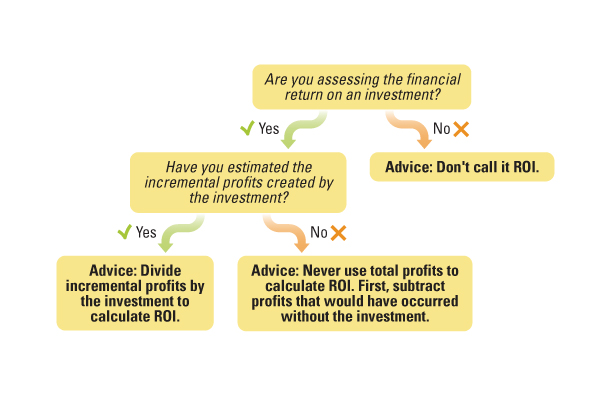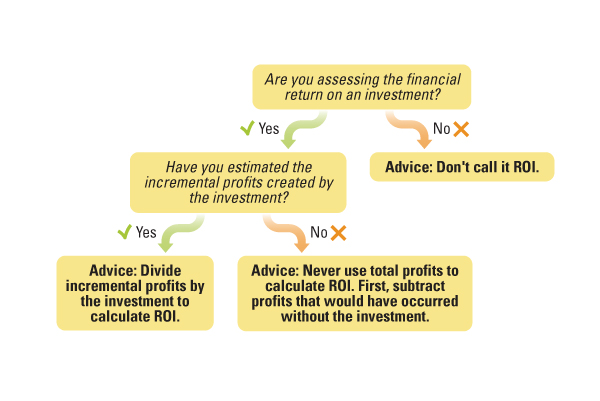Return on investment (ROI) is a good thing. It conjures up all sorts of positive connotations. As such it is understandable that marketers want to use the term. The challenge is that often it is used in a ‘motherhood and apple pie’ sort of way. If you can point to something good then you call it ROI. This is a problem as something being good isn’t really the same as demonstrating ROI. Think of ROI as a subset of things that are good. ROI is good but not everything that is good is ROI. Puppies are adorable but not everything that is adorable is a puppy. Indeed, I might argue that ROI is the most abused term in marketing.

What Is ROI For?
The most basic question to ask is: What is ROI for? This will help give us an idea whether the term is being used correctly.
I will start with the basic notion that ROI is a metric used to compare the effectiveness of different investments. We can go to Wikipedia and see that (at time of writing) the definition is given as “Return on investment (ROI) is a ratio between net profit (over a period) and cost of investment (resulting from an investment of some resources at a point in time). ” It is popular to demean Wikipedia definitions, and often they can be a bit dodgy. That said, if Wikipedia is far from perfect we should also ensure that we are no worse than this. The key point from the definition is that ROI compares the profit made on an investment with the investment itself.
Who Uses ROI?
Closely following up on the ‘what is ROI for’ question is who uses it. This is critical for helping us to be quite dogmatic about the way ROI is presented. ROI is used to compare investments. This comparison could be made after the investments are made but managers often estimate ROI before the investment is made. (Estimates of future ROI are easier to use in decisions than historical reviews afterwards. Even if people look at ROI in retrospect it is likely they are doing so to learn some lessons about the future).
As such we get the idea that ROI is used by those who compare possible investments. They use these estimates to pick which are the best investments to make. Now this only makes sense when resources are constrained — if resources are not constrained one should pick all NPV positive investments. The good, and bad, news being that resources being constrained is basically always true; time is ultimately constrained even if cash is flush for a period. As such ROI typically is useful.
If ROI is used to decide between investments then those who will use ROI are those making decisions between investments — so high level financial decision makers. These include senior marketing managers, CMOs, Finance officers, CFOs, and ultimately CEOs.
What Do We Need For ROI To Be Used to Compare Investments?
To be useful for comparison those using ROI need to mean the same thing when they say ROI. It is fashionable in marketing to call any number of things are ROI.
- You have achieved greater awareness? That is ROI, apparently.
- You have some soft of positive movement in a brand love measure. That is called ROI.
- Retweets, that is ROI?
- I even saw a picture labelled ROI the other day, see here.
To see why this is nonsense, consider a CFO trying to decide whether to invest in operations or marketing. The operations people give details of a project to automatic some process that has an estimated ROI of 12%, the marketers say awareness will be up 30 percentage points. The marketers comment, even assuming it is true, is useless for the decision maker. Awareness is good (mostly), and this increase likely has some financial impact. Yet, how can it be compared to the 12% from Ops? It can’t. The marketers have completely failed to be useful to the decision maker.
Is ROI The Most Abused Term In Marketing? Maybe If You Think Awareness Is The Same As ROI
I in no way want to imply that awareness (or whatever) could not lead to ROI. The point is that showing one isn’t the same as showing the other. Awareness, for example, is typically useful but can’t be directly compared to ROI.
How Then To Measure ROI?
ROI can be complicated. It is surprisingly hard to work out what the historic return of an investment was, never mind project the return for future projects. Similarly investments are rarely quite as simple as they first appear. (How to deal with all the costs related to an investment).
Despite the complexities the basic formula is simple:
Return on Investment (%) = Return ($) / Investment ($)
If anyone tries to use another formula than this please just smile and ignore them.
There is much more on ROI in the 4th Edition of Marketing Metrics.
Our Work In The MIT Sloan Management Review
With Charan Bagga (now at the University of Calgary) I produced a simple guide for using a few marketing metrics. Here is what we said about ROI.

Neil T. Bendle and Charan K. Bagga May 18, 2016 https://sloanreview.mit.edu/article/are-you-using-the-return-on-investment-metric-correctly/
Summary
Is ROI is the most abused term in marketing? It could well be. (Sadly I don’t have the data to properly test this notion). Still, when using ROI remember that it has a specific meaning. The metric is useful in so far as it is comparable across projects. Don’t use ROI as shorthand for anything good. There are many good things in the world, including puppies, this doesn’t make them ROI.
If it ain’t a percentage it ain’t ROI.
Neil Bendle
To Find Out More
For an in depth discussion of ROI read James Lenskold’s Book.
My blog contains a number of discussions of ROI (and its misuse).

